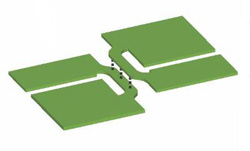Researchers develop one of the world’s smallest electronic circuits

A team of scientists, led by Guillaume Gervais from McGill’s Physics Department and Mike Lilly from Sandia National Laboratories, has engineered one of the world's smallest electronic circuits. It is formed by two wires separated by only about 150 atoms or 15 nanometers (nm).
This discovery, published in the journal Nature Nanotechnology, could have a significant effect on the speed and power of the ever smaller integrated circuits of the future in everything from smartphones to desktop computers, televisions and GPS systems.
This is the first time that anyone has studied how the wires in an electronic circuit interact with one another when packed so tightly together. Surprisingly, the authors found that the effect of one wire on the other can be either positive or negative. This means that a current in one wire can produce a current in the other one that is either in the same or the opposite direction. This discovery, based on the principles of quantum physics, suggests a need to revise our understanding of how even the simplest electronic circuits behave at the nanoscale
In addition to the effect on the speed and efficiency of future electronic circuits, this discovery could also help to solve one of the major challenges facing future computer design. This is managing the ever-increasing amount of heat produced by integrated circuits. Well-known theorist Markus Büttiker speculates that it may be possible to harness the energy lost as heat in one wire by using other wires nearby. Moreover, Buttiker believes that these findings will have an impact on the future of both fundamental and applied research in nanoelectronics.
To read the article: Nature Nanotechnology, http://www.nature.com/nnano/journal/vaop/ncurrent/full/nnano.2011.182.html
The research was funded by: The Natural Sciences and Engineering Research Council of Canada, the Fonds de recherche Nature et Technologies of Quebec, the Canadian Institute for Advanced Research and the Center of Integrated Nanotechnologies at Sandia National Laboratories.
Media Contact
More Information:
http://www.mcgill.ca/newsroom/All latest news from the category: Physics and Astronomy
This area deals with the fundamental laws and building blocks of nature and how they interact, the properties and the behavior of matter, and research into space and time and their structures.
innovations-report provides in-depth reports and articles on subjects such as astrophysics, laser technologies, nuclear, quantum, particle and solid-state physics, nanotechnologies, planetary research and findings (Mars, Venus) and developments related to the Hubble Telescope.
Newest articles

A universal framework for spatial biology
SpatialData is a freely accessible tool to unify and integrate data from different omics technologies accounting for spatial information, which can provide holistic insights into health and disease. Biological processes…

How complex biological processes arise
A $20 million grant from the U.S. National Science Foundation (NSF) will support the establishment and operation of the National Synthesis Center for Emergence in the Molecular and Cellular Sciences (NCEMS) at…

Airborne single-photon lidar system achieves high-resolution 3D imaging
Compact, low-power system opens doors for photon-efficient drone and satellite-based environmental monitoring and mapping. Researchers have developed a compact and lightweight single-photon airborne lidar system that can acquire high-resolution 3D…





















